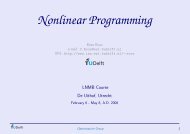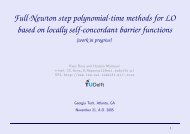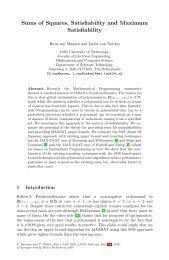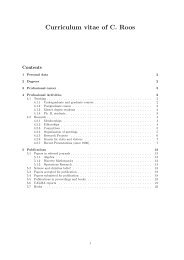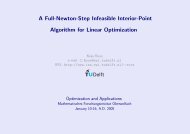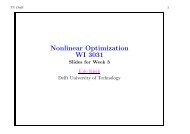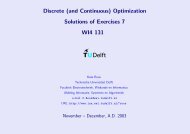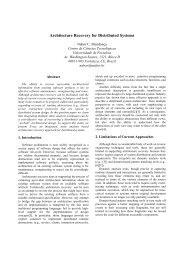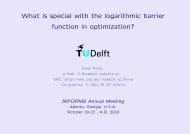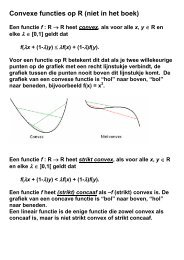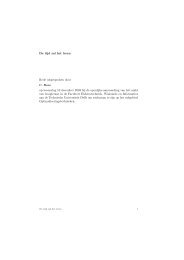On improving efficiency of model checking through systematically ...
On improving efficiency of model checking through systematically ...
On improving efficiency of model checking through systematically ...
You also want an ePaper? Increase the reach of your titles
YUMPU automatically turns print PDFs into web optimized ePapers that Google loves.
Chapter 4<br />
Case studies<br />
This chapter contains four systems which are <strong>of</strong> different complexity and<br />
application domains chosen as case studies for our approach. We roughly<br />
classify them according to physical size and characteristic <strong>of</strong> the state space.<br />
We define classification standards as follows:<br />
1. Physical size: In our context, physical size is represented by the<br />
number <strong>of</strong> locations, transitions, Boolean operators, and variables.<br />
Since input <strong>model</strong>s are merely text files, the physical size may have<br />
significant impact on the performance <strong>of</strong> tools applied. Our goal is to<br />
see whether or not the physical size <strong>of</strong> a system affects the <strong>efficiency</strong><br />
<strong>of</strong> verification. We define two categories: small and large. A system<br />
is categorized as small in physical size if the total number <strong>of</strong> locations,<br />
transitions, Boolean operators, and variables is less than 10000 and<br />
vice versa.<br />
2. Characteristic <strong>of</strong> the state space: Two categories are defined including<br />
Finite and Infinite. We found two reasons for which a state<br />
space becomes infinite:<br />
(a) The system involves unbounded numerical variables.<br />
(b) The existence <strong>of</strong> real-time in the system.<br />
We characterize the state space <strong>of</strong> <strong>model</strong>s in the perspective <strong>of</strong> Uppaal<br />
<strong>model</strong> <strong>checking</strong> approach. In an infinite system due to unbounded variables,<br />
the iterative resolution <strong>of</strong> a fixed point equation defined by Uppaal involves<br />
infinite iterations. Note that the fixed point equation defined by Nbac may<br />
have a solution. It depends on the type <strong>of</strong> values on which the fixed point<br />
equation is defined. For example, values x =(1..n) may be abstracted as a<br />
unique value pos = x>0inNbac. In this case, if x always increases, the<br />
37



